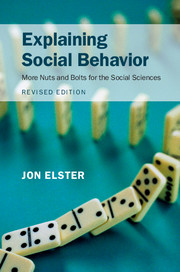Book contents
- Frontmatter
- Dedication
- Contents
- Preface
- I Explanation and Mechanisms
- II The Mind
- III Action
- IV Interaction
- 17 Unintended consequences
- 18 Strategic interaction
- 19 Games and behavior
- 20 Trust
- 21 Social norms
- 22 Collective belief formation
- 23 Collective action
- 24 Collective decision making
- 25 Institutions and constitutions
- Conclusion: is social science possible?
- Index
21 - Social norms
from IV - Interaction
Published online by Cambridge University Press: 05 August 2015
- Frontmatter
- Dedication
- Contents
- Preface
- I Explanation and Mechanisms
- II The Mind
- III Action
- IV Interaction
- 17 Unintended consequences
- 18 Strategic interaction
- 19 Games and behavior
- 20 Trust
- 21 Social norms
- 22 Collective belief formation
- 23 Collective action
- 24 Collective decision making
- 25 Institutions and constitutions
- Conclusion: is social science possible?
- Index
Summary
The collective consciousness
Sociologists sometimes refer to the “collective consciousness” of a community, the set of values and beliefs shared (and known or believed to be shared) by its members. On the value side, the collective consciousness includes moral and social norms, religion, and political ideologies. On the belief side, it includes opinions about factual matters as well as about causal relations, ranging from rumors about the white slave trade to beliefs about the perverse effects of unemployment benefits. In this chapter I consider social norms and their operation. In the next chapter, I consider modes of collective or, better, interactive belief formation. There is a double asymmetry in my treatment of values and beliefs. On the one hand, I have little to say about the emergence of social norms, not because the question is uninteresting but because I find it too hard. On the other hand, I have little to say about the substance of popular or collective beliefs. Their content varies greatly in time and space, whereas the mechanisms of emergence, propagation, change, and collapse of beliefs are more invariant.
The operation of social norms
Consider two statements:
Always wear black clothes in strong sunshine.
Always wear black clothes at a funeral.
The first injunction is a matter of instrumental rationality, since the air between the body and the clothes circulates more rapidly when the garments are black. The second expresses a social norm, which has no obvious instrumental significance. The existence and importance of social norms cannot be doubted. The proximate causes involved in their operation are reasonably well understood. Yet their ultimate origin and function (if any) remain controversial.
A social norm is an injunction to act or to abstain from acting. Some norms are unconditional: “Do X; do not do Y.” They include the norms not to eat human flesh, not to have sexual intercourse with a sibling, not to break into the queue, never to wear red clothes (as some mothers tell their daughters), to wear black clothes at a funeral, to begin with the outermost knife and fork and work inward toward the plate, to treat the sickest patient first (even if the chances of curing him are worse than those for other patients).
- Type
- Chapter
- Information
- Explaining Social BehaviorMore Nuts and Bolts for the Social Sciences, pp. 347 - 364Publisher: Cambridge University PressPrint publication year: 2015
- 1
- Cited by

